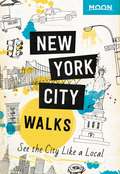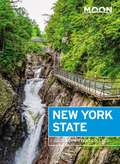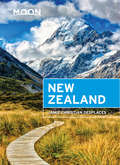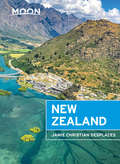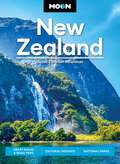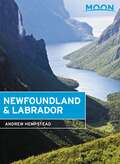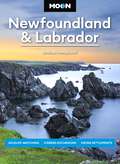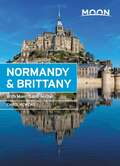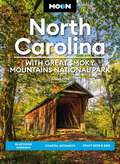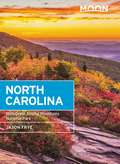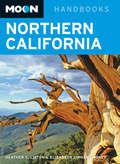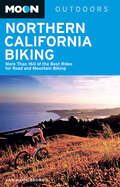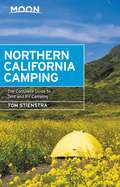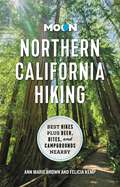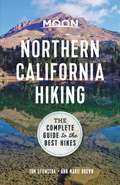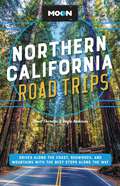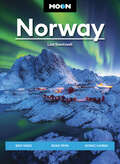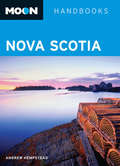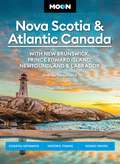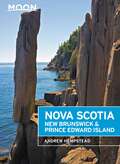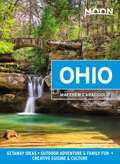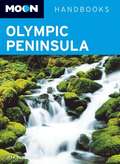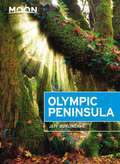- Table View
- List View
Moon New York City Walks: See the City Like a Local (Travel Guide)
by Moon Travel GuidesExperience the city that never sleeps like a local: on foot! Whether you're strolling along tree-lined streets in the Village or hustling down Fifth Avenue, discover the best of the Big Apple with Moon New York City Walks.Walk through the city's coolest neighborhoods, including Soho, the West Village, the Lower East Side, Williamsburg, and more, with color-coded stops and turn-by-turn directionsFind your scene with top ten lists for restaurants, arts and culture, and coffeeGet to know the real New York on six customizable walks: Stroll past icons like the Flatiron Building, the Empire State Building, and Rockefeller Center, or learn more about the history of jazz and the Harlem Renaissance. Take in jaw-dropping views along the High Line, shop the trendiest brands in the Meatpacking District, and explore world-famous galleries and museums. Cross the Williamsburg Bridge, hit a flea market, and discover coffee shops tucked among the Brooklyn warehouses. Sample authentic Chinese noodles and dim sum, comforting soul food, and old-school deli standbys, or admire the city skyline from one of New York's many rooftop barsExplore on the go with foldout maps of each walking route and a removable full-city map, all in a handy guide that fits in your pocketDiscover public transportation options like bike rentals, subway, taxis, buses, and ferriesWith creative routes, public transit options, and a full-city map, you can explore New York at your own pace, without missing a beat.Check out our guides to more of the world's best cities, so you can hit the ground running! Also available: Moon Barcelona Walks, Moon Berlin Walks, Moon Tokyo Walks, Moon Amsterdam Walks, Moon Paris Walks, Moon Rome Walks, and Moon London Walks.
Moon New York State: Getaway Ideas, Road Trips, Local Spots (Travel Guide)
by Julie Schwietert CollazoFrom museum-hopping in the Hudson Valley to hiking the hills upstate, discover the New York you don't know with Moon New York State. Inside you'll find:Strategic itineraries ranging from a two-week road trip to weekend getaways from the city, with ideas for art-lovers, foodies, outdoor enthusiasts, foliage-seekers, and moreDay trips from New York City to Long Island, the Hudson Valley, and the CatskillsThe top sights and unique experiences: Explore the charming riverside towns of the Hudson Valley on a brewery trail, sample local wine and cheese upstate, or relax on the beaches of Montauk. Hike to a spectacular sunrise in the Catskills, kayak on the Finger Lakes, and peep the vibrant changing leaves in the Adirondacks. Browse the quirky boutiques of Lower Manhattan, stroll the High Line, and savor skyline views with a nightcap in hand at a rooftop barHonest advice from native New Yorker Julie Schwietert Collazo on when to go, where to stay, and how to get aroundFull-color photos and detailed maps throughoutThorough background on the history, culture, and geography of the stateRecommendations for families, LGBTQ travelers, seniors, international visitors, and travelers with disabilitiesWith Moon New York State's practical tips and local insight, you can experience the best of the Empire State.Want to experience NYC like a local? Check out Moon New York City.
Moon New York Walks
by Moon Travel GuidesExperience the Big Apple like a local: on foot!Moon New York Walks guides you to the trendiest restaurants, buzzworthy boutiques, and iconic landmarks of New York City's can't-miss neighborhoods. This full-color guide to "the city that never sleeps" features:Six customizable walks through the city's hippest neighborhoods, including Soho, the West Village, the Lower East Side, Williamsburg, and more, with color-coded stops and turn-by-turn directionsFoldout maps of each route and a removable full-city map, in a handy, portable guideCurated "Top Ten" lists for dining, arts and culture, nightlife, and (of course) coffee, for visitors looking to hit the highlightsThe top attractions and the best-kept local secrets: Stroll down Fifth Avenue past icons like the Flatiron, the Empire State Building, and Rockefeller Centre, or walk along the Hudson River and learn the history of jazz and the Harlem Renaissance. Take in jaw-dropping views along the High Line, shop for trendy trinkets in the Meatpacking District, and explore world-famous galleries and museums. Cross the Williamsburg Bridge, peruse a flea market, and discover hip coffee shops tucked among the Brooklyn warehouses. Sample authentic dumplings in Chinatown, old-school deli standbys, or healthy vegan treats. Sip craft cocktails in an underground speakeasy, or admire the city skyline from a rooftop barPublic transportation options, including the subway, bus, taxi, or bike rentalTips for first-time visitors, including seasonal festivals, where you'll need to make a reservation, and getting to and from the airportWith creative routes, public transit options, and a full-city map, you can explore New York at your own pace, without missing a beat.Check out our guides to more of the world's liveliest cities, so you can hit the ground running! Also available: Moon Barcelona Walks, Moon Berlin Walks, Moon London Walks, Moon Amsterdam Walks, Moon Paris Walks, and Moon Rome Walks
Moon New Zealand (Travel Guide)
by Jamie Christian DesplacesFrom green forests to blackened basalt, from snowy mountains to golden beaches, adventure awaits around every bend on these dramatic islands. Dive into Middle Earth with Moon New Zealand. Inside you'll find:Strategic itineraries including a week on both the North and South Islands, designed for hikers, cyclers, adrenaline junkies, history and culture buffs, and Lord of the Rings fansThe top spots for outdoor adventures, including surfing, bungy jumping, mountain biking, and trekking the Great Walks, as well as tips on how to do a New Zealand road tripThe top sights and unique experiences: Cruise the hypnotic black waters of the Milford Sound, spot wild dolphins, kiwis, and blue penguins, and explore the sprawling Waitomo Caves lit by twinkling glowworms. Go bungy jumping, paragliding, or jet skiing in Queensland, or soak in refreshing thermal pools. Embark on a multi-day trek to rugged coasts, glacial valleys, volcanoes, and fjords. Sample local sauvignon blancs in Marlborough and craft beers in Wellington, or sip cider in the Shire. Learn about Polynesian culture and history, marvel at Maori carvings, and savor a traditional hangiHow to experience New Zealand like an insider, support local and sustainable businesses, avoid crowds, and respectfully engage with the indigenous cultureExpert insight from Aukland local Jamie Christian Desplaces on when to go, how to get around, and where to stay Full-color photos and detailed maps throughout, plus a full-color detachable mapReliable background information on the landscape, climate, wildlife, and history, as well as common customs and etiquette Travel tips for seniors, families with children, visitors with disabilities, and LGBTQ travelersWith Moon New Zealand's expert advice and local insight, you can plan your trip your way.
Moon New Zealand (Travel Guide)
by Jamie Christian DesplacesFrom green forests to blackened basalt and snowy mountains to golden beaches, adventure awaits around every bend on these dramatic islands. Experience Middle Earth with Moon New Zealand. Inside you'll find:Strategic itineraries including a week on both the North and South Islands, designed for hikers, cyclists, adrenaline junkies, history and culture buffs, and Lord of the Rings fansThe top spots for outdoor adventures, like surfing, mountain biking, and trekking the Great Walks, as well as tips on how to do a New Zealand road trip. Go bungy jumping, paragliding, or jet skiing in Queensland, soak in refreshing thermal pools, or embark on a multi-day trek to rugged coasts, glacial valleys, volcanoes, and fjordsCan't-miss sights and unique experiences: Cruise the hypnotic black waters of the Milford Sound, spot wild dolphins, kiwis, and blue penguins, and explore the sprawling Waitomo Caves lit by twinkling glowworms. Sample local sauvignon blancs in Marlborough and craft beers in Wellington, or sip cider in the Shire. Learn about Polynesian culture and history, marvel at Maori carvings, and savor a traditional hangiHow to experience New Zealand like an insider, support local and sustainable businesses, avoid crowds, and respectfully engage with the indigenous culture, with expert insightfrom Aukland local Jamie Christian DesplacesFull-color photos and detailed maps throughout, plus a full-color detachable mapReliable background information on the landscape, climate, wildlife, and history, as well as common customs and etiquetteHelpful resources on COVID-19 and traveling to New ZealandTravel tips: When to go, how to get around, and where to stay, plus advice for seniors, families with children, visitors with disabilities, and LGBTQ+ travelersWith Moon's expert advice and local insight, you can experience the best of New Zealand. About Moon Travel Guides: Moon was founded in 1973 to empower independent, active, and conscious travel. We prioritize local businesses, outdoor recreation, and traveling strategically and sustainably. Moon Travel Guides are written by local, expert authors with great stories to tell—and they can't wait to share their favorite places with you.For more inspiration, follow @moonguides on social media.
Moon New Zealand: Great Walks & Road Trips, Cultural Insights, National Parks (Moon Asia & Pacific Travel Guide)
by Jamie Christian Desplaces Moon Travel GuidesFrom snowy mountains to golden beaches, beauty awaits around every bend on these dramatic islands. Find your adventure with Moon New Zealand. Inside you'll find:Strategic, flexible itineraries, including a trip to experience both the North and South Islands in 16 days The top spots for outdoor adventures, like surfing, mountain biking, and trekking the Great Walks, as well as tips for taking an epic road trip. Go bungee jumping or paragliding, soak in refreshing thermal pools, or embark on a multi-day trek to rugged coasts, glacial valleys, volcanoes, and fjords Can't-miss sights and unique experiences: Cruise the hypnotic black waters of the Milford Sound, spot wild dolphins, kiwis, and blue penguins, and explore the sprawling Waitomo Caves lit by twinkling glowworms. Sample local sauvignon blancs in Marlborough and craft beers in Wellington, or sip cider in the Shire. Learn about Polynesian culture and history, marvel at Māori carvings, and experience a traditional hangi meal How to experience New Zealand like an insider, support local and sustainable businesses, avoid crowds, and respectfully engage with indigenous culture, with expert insight from Auckland local Jamie Christian Desplaces Full-color photos and detailed maps throughout, plus a full-color detachable map Essential background information on the landscape, climate, wildlife, and history, as well as common customs and etiquette Travel tips: When to go, how to get around, and where to stay, plus advice for seniors, families with children, visitors with disabilities, and LGBTQ+ travelers Experience the best of New Zealand with Moon's expert advice and local insight. Visiting more of the South Pacific? Check out Moon Tahiti & French Polynesia.About Moon Travel Guides: Moon was founded in 1973 to empower independent, active, and conscious travel. We prioritize local businesses, outdoor recreation, and traveling strategically and sustainably. Moon Travel Guides are written by local, expert authors with great stories to tell—and they can't wait to share their favorite places with you. For more inspiration, follow @moonguides on social media.
Moon Newfoundland & Labrador: Nova Scotia, New Brunswick, Prince Edward Island, Newfoundland And Labrador (Travel Guide)
by Andrew HempsteadAwe-inspiring icebergs, clifftop lighthouses, and rare fossils: experience the magic of Canada's eastern province with Moon Newfoundland & Labrador. Inside you'll find:Flexible itineraries for weekend getaways or spending two weeks in Newfoundland and Labrador with strategic advice for families, outdoor adventurers, and history buffsTop experiences: Visit an active archaeological dig or learn about the history and local art of the province while touring The Rooms cultural center. Chow down on fresh crab claws, chowder, and pie made with locally grown berries. Drive the Irish Loop for with stunning coastal views, maritime history, and wildlife-watching, and wind down at a cozy neighborhood pubBest outdoor adventures: Trek through hilly evergreen forests alongside moose, foxes, and caribou. Watch for whales on a cruise or search the sky for soaring eagles, ospreys, and puffins. Embark on a multi-day backpacking adventure through the UNESCO-protected Gros Morne National Park. Kayak to the remote wilderness of Torngat Mountains National Park or scuba dive in shipwreck-filled coves, and settle down for a night under the starry sky at a lakeside campsiteExpert advice from Canadian Andrew Hempstead on when to go, where to stay, and how to get aroundFull-color photos and detailed maps throughoutBackground information on the environment, culture, and historyExperience the best of Newfoundland and Labrador with Moon's practical tips and local insight. Expanding your trip? Try Moon Atlantic Canada or Moon Canadian Rockies. About Moon Travel Guides: Moon was founded in 1973 to empower independent, active, and conscious travel. We prioritize local businesses, outdoor recreation, and traveling strategically and sustainably. Moon Travel Guides are written by local, expert authors with great stories to tell—and they can't wait to share their favorite places with you.For more inspiration, follow @moonguides on social media.
Moon Newfoundland & Labrador: Wildlife-Watching, Iceberg Excursions, Viking Settlements (Moon Canada Travel Guide)
by Andrew Hempstead Moon Travel GuidesAwe-inspiring icebergs, clifftop lighthouses, and rare fossils: experience the magic of Canada's easternmost province with Moon Newfoundland & Labrador.Flexible itineraries for weekend getaways or spending 7 days in Newfoundland and Labrador Top experiences: Visit an active archaeological dig or learn about the history and local art of the province. Chow down on fresh crab claws, chowder, and pie made with locally grown berries. Drive the Irish Loop for stunning coastal views, maritime history, and wildlife-watching, and wind down after at a cozy neighborhood pub Best outdoor adventures: Trek through hilly evergreen forests and spot moose, foxes, and caribou. Watch for whales on a cruise or search the sky for soaring eagles, ospreys, and puffins. Embark on a multi-day backpacking adventure through the UNESCO-protected Gros Morne National Park. Kayak to the remote wilderness of Torngat Mountains National Park, scuba dive in shipwreck-filled coves, or settle down for a night under the stars at a lakeside campsite Expert advice from Canadian Andrew Hempstead on when to go, where to stay, and how to get around Full-color photos and detailed maps throughoutBackground information on the environment, culture, and history With Moon's practical tips and local insight, you can experience the best of Newfoundland and Labrador. Expanding your trip? Try Moon Nova Scotia & Atlantic Canada. Headed west? Check out Moon Vancouver & Canadian Rockies Road Trip. About Moon Travel Guides: Moon was founded in 1973 to empower independent, active, and conscious travel. We prioritize local businesses, outdoor recreation, and traveling strategically and sustainably. Moon Travel Guides are written by local, expert authors with great stories to tell—and they can't wait to share their favorite places with you. For more inspiration, follow @moonguides on social media.
Moon Normandy & Brittany: With Mont-Saint-Michel (Travel Guide)
by Chris NewensDramatic coastline, charming villages, unforgettable history, and distinct local culture: See a different side of France with Moon Normandy & Brittany. Inside you&’ll find:Flexible itineraries for 1 to 5 days in Normandy and Brittany that can be combined into a 2-week trip, plus suggestions for easy side tripsStrategic advice for foodies, art lovers, history buffs, outdoor adventurers, and more Must-see highlights and unique experiences: Hike the dramatic chalk cliffs of Étretat or stroll the gardens that inspired Monet's Water Lilies. Cycle the rolling hills and endless backroads to small villages and sip cider with locals at a Celtic Festoù-noz pulsing with traditional dance and music. Pay your respects at the D-Day beaches and monuments and learn about the largest military landing in history. Admire the spectacular monastery rising above the tidal plains of Mont Saint Michel and enjoy fresh seafood in Saint-Malo Honest advice on where to stay, how to get around, and where to find the best regional cuisine, from creamy cheeses in Normandy to Breton galettes and cider Local perspective from British expat and local expert Chris Newens Full-color photos and detailed maps throughoutHelpful resources on COVID-19 and traveling to Normandy and Brittany Background information on the landscape, history, and cultural customs of each region Handy tools such as a French phrasebook and tips for traveling with children or as a senior Experience the best of Normandy and Brittany with Moon. Exploring more of France? Try Moon Provence or Moon French Riviera. About Moon Travel Guides: Moon was founded in 1973 to empower independent, active, and conscious travel. We prioritize local businesses, outdoor recreation, and traveling strategically and sustainably. Moon Travel Guides are written by local, expert authors with great stories to tell—and they can't wait to share their favorite places with you. For more inspiration, follow @moonguides on social media.
Moon North Carolina: Blue Ridge Parkway, Coastal Getaways, Craft Beer & BBQ (Travel Guide)
by Jason FryeFrom the Outer Banks to Asheville, discover the best of the Tar Heel State with Moon North Carolina. Inside you'll find:Flexible itineraries, including scenic drives along the Blue Ridge Parkway, four days in the Great Smoky Mountains, and a five-day coastal getaway Strategic advice designed for hikers, beach-goers, foodies, wildlife-watchers, and more The top local experiences: Explore the gardens of the Biltmore Estate, check out the art museum in Raleigh, or kick back with a craft beer at an outdoor concert in Wilmington. Escape to the Outer Banks for a glimpse of wild horses, historic lighthouses, and remote islands. Tap your foot to live bluegrass and dig into famous North Carolina barbecue Outdoor activities: Hike to waterfalls or challenge yourself to climb the highest peaks in Great Smoky Mountains National Park. Kayak around Kitty Hawk, whitewater raft in the wild Nantahala River Gorge, go hang gliding, or spend a day fly-fishing Expert tips from North Carolina local Jason Frye on when to go, how to get around, and where to stay, from rugged campgrounds to historic inns and beachside B&Bs Full-color photos and detailed maps throughout Thorough background on the landscape, climate, wildlife, and local culture With Moon North Carolina's expert advice and local insight, you can find your adventure. Focusing on the mountains? Check out Moon Asheville & the Great Smoky Mountains. Can't get enough of the beach? Try Moon North Carolina Coast. About Moon Travel Guides: Moon was founded in 1973 to empower independent, active, and conscious travel. We prioritize local businesses, outdoor recreation, and traveling strategically and sustainably. Moon Travel Guides are written by local, expert authors with great stories to tell—and they can't wait to share their favorite places with you. For more inspiration, follow @moonguides on social media.
Moon North Carolina: With Great Smoky Mountains National Park (Travel Guide)
by Jason FryeFrom the Outer Banks to Asheville, discover the best of the Tar Heel State with Moon North Carolina. Inside you'll find:Flexible itineraries, including scenic drives along the Blue Ridge Parkway, a weekend in Great Smoky Mountains National Park, and getaways to Asheville, Raleigh-Durham, and CharlotteStrategic advice designed for hikers, beach-goers, foodies, wildlife-watchers, and moreThe top local experiences: Explore the gardens of the Biltmore Estate, check out the art museum in Raleigh, or kick back with a craft beer at an outdoor concert in Wilmington. Escape to the Outer Banks for a glimpse of wild horses, historic lighthouses, and remote islands. Tap your foot to live bluegrass and dig in to famous North Carolina barbecueOutdoor activities: Hike to waterfalls or challenge yourself to climb the highest peaks in Great Smoky Mountains National Park. Kayak around Kitty Hawk, whitewater raft in the wild Nantahala River Gorge, hang glide, or spend a day fly-fishingExpert tips from North Carolina local Jason Frye on when to go, how to get around, and where to stay, from rugged campgrounds to historic inns and beachside B&Bs Full-color photos and detailed maps throughout Thorough background on the landscape, climate, wildlife, and local cultureWith Moon North Carolina's expert advice and local insight, you can find your adventure.Focusing on the mountains? Check out Moon Asheville & the Great Smoky Mountains. Can't get enough of the beach? Try Moon North Carolina Coast.
Moon Northern California
by Elizabeth Linhart Veneman Heather C. ListonCalifornia residents Heather C. Liston and Elizabeth Linhart Money cover the best that Northern California has to offer, from day hikes in awe-inspiring Yosemite Valley to rest and relaxation at the spas and vineyards of Wine Country. To help travelers plan their trip, Liston and Money also offer a number of unique itinerary ideas, such as as Winter Wonderland, Culinary Culture, and Driving the Coast-a 10-day tour down Northern California's winding, scenic coastline. With expert advice on finding the tastiest food in the Bay Area, exploring the Big Sur coast, and getting to Gold Country ghost towns-and now with expanded coverage of the many outdoor recreation opportunities available in the region-Moon Northern California gives travelers the tools they need to create a more personal and memorable experience.
Moon Northern California Biking: More than 160 of the Best Rides for Road and Mountain Biking (Moon Outdoors)
by Ann Marie BrownAvid biker and experienced travel writer Ann Marie Brown knows the best places to cycle in Northern California, from steep ocean-front rides to meandering, scenic trails through Sonoma and Napa. Moon Northern California Bikingguides seasoned riders and beginning bikers to the best trails, paths, and roads throughout the San Francisco Bay Area, Tahoe, Yosemite, and Northern California wine country. Complete with elevation charts, route maps, and options to extend or shorten each route, as well as information on bike shops, riding clubs, and bike organizations throughout the region,Moon Northern California Bikinggives bicyclists the tools they need to create a more personal and memorable experience.
Moon Northern California Camping: The Complete Guide to Tent and RV Camping (Moon Handbooks)
by Tom StienstraWhether you're camping among towering redwoods, along rugged coastline, or in the High Sierra, you'll always find your perfect campsite with Moon Northern California Camping.A Campsite for Everyone: Pick the right tent or RV site with options ranging from secluded Sierra hike-ins to convenient roadside stopovers, including dog-friendly, family-friendly, and wheelchair accessible options, and strategic lists of the best campgrounds for hiking, swimming, and moreRatings and Essentials: All campgrounds are rated on a scenic scale and marked with amenities like restrooms, trailhead access, picnic areas, laundry, piped water, showers, and playgroundsRecreation Highlights: Discover nearby hiking, swimming, fishing, biking, water-skiing, white water rafting, and hot springsMaps and Directions: Easy-to-use maps and detailed driving directions for each campgroundSkip the Crowds: Moon Northern California Camping contains many secluded spots and campgrounds that aren't available in the state's online reservation systemTrailhead Access Campgrounds: Find sites that offer access to the John Muir Trail, the Pacific Crest Trail, and more, plus essential information on hikingExpert Advice: Expert outdoorsman Tom Stienstra knows his stuff; he's hiked 25,000 miles in and around these campgrounds for over 30 yearsTips and Tools: Information on equipment, food and cooking, first aid, and insect protection, plus background on the climate, landscape, and history of the campsitesWhether you're a veteran or a first-time camper, Moon's comprehensive coverage and local insight will have you gearing up for your next adventure.Exploring more of the Golden State? Try Moon California Camping. Looking for some focused advice on outdoor recreation? Check out Moon California Hiking.
Moon Northern California Hiking: Best Hikes Plus Beer, Bites, and Campgrounds Nearby (Moon Hiking Travel Guide)
by Ann Marie Brown Moon Travel Guides Felicia KempPack a lunch, lace up your boots, and head out to discover the rugged coastline, towering redwoods and best hiking trails in NorCal with Moon Northern California Hiking. Inside you'll find:Diverse Hiking Options: Whether you plan to take leisurely seaside walks or challenging journeys around the Sierras, enjoy outdoor getaways ranging from easy day hikes to multi-day backpacking trips Find Your Hike: Looking for something specific? Choose from strategic lists of the best hikes for breathtaking waterfalls, spring wildflowers, or hiking with your dog, plus a breakdown of the best hikes by season The Top Outdoor Experiences: Wander the terraces of the Ecological Staircase in Mendocino, hike up granite domes and through the high meadows of Yosemite. Hear the waves crash as you walk to a majestic tide fall in Point Reyes National Seashore. Conquer the summit of Lassen Peak, roam through vineyard-covered hills in Napa and Sonoma or look out upon Lake Tahoe's crystal waters. Nearby Fun: Relax post-hike at a local brewery, savor a plate of fresh oysters or stargaze before bed at a nearby campground Essential Planning Details: Each hike is described in detail and marked with round-trip distance and hiking time, difficulty, terrain type, elevation gain, and access points Maps and Directions: Find easy-to-use maps, driving directions to each trailhead, and details on where to park Expert Advice: Longtime hikers Ann Marie Brown and Felicia Kemp shares their local secrets, unique tips, and honest opinions of each trail Tips and Tools: Advice on gear, first aid, and camping permits, plus background information on climate, landscape, and wildlife Whether you're a veteran or a first-time hiker, Moon's comprehensive coverage and local expertise will have you gearing up for your next adventure.About Moon Travel Guides: Moon was founded in 1973 to empower independent, active, and conscious travel. We prioritize local businesses, outdoor recreation, and traveling strategically and sustainably. Moon Travel Guides are written by local, expert authors with great stories to tell—and they can't wait to share their favorite places with you. Hitting the road? Check out Moon Northern California Road Trips!
Moon Northern California Hiking: The Complete Guide to the Best Hikes (Moon Outdoors)
by Ann Marie Brown Tom StienstraPack a lunch, lace up your boots, and head out to discover the best hiking trails in NorCal with Moon Northern California Hiking.A Hike for Everyone: Pick the right hike for you, from breathtaking coastal walks to challenging backcountry treks, with options ranging from easy day hikes to multi-day backpacking tripsBest Hikes Lists: Choose from strategic lists like the best hikes for majestic redwoods, bird-watching, refreshing swimming holes, wheelchair accessibility and moreEssential Planning Details: Each hike is marked with round-trip distance and hiking time and rated for scenic beauty and trail difficultyMaps and Directions: Find easy-to-use maps, driving directions to each trailhead, and details on where to parkSkip the Crowds: Have the trail to yourself with Moon Northern California Hiking's many off-the-radar hikesExpert Advice: Seasoned hikers Tom Stienstra and Ann Marie Brown offer their experienced insight and honest opinions on each trailTips and Tools: Advice on gear, first aid, ethical hiking, and camping permits, plus background information on climate, landscape, and wildlifeWhether you're a veteran or a first-time hiker, Moon's comprehensive coverage and honest expertise will have you gearing up for your next adventure.Exploring more of the Golden State? Try Moon California Hiking. Hitting the road? Check out Moon California Road Trip.
Moon Northern California Road Trips: Drives along the Coast, Redwoods, and Mountains with the Best Stops along the Way (Travel Guide)
by Stuart Thornton Kayla AndersonExplore iconic San Francisco, stroll along foggy coastal cliffs, or climb the peaks of the Sierra Nevada: Answer the call of the open road with Moon Northern California Road Trips. Pick Your Road Trip: Find flexible getaways throughout NorCal, like three-day routes through Wine Country, Lake Tahoe, Monterey and Big Sur, and more, or combine them for an epic 21-day driving tour Eat, Sleep, Stop and Explore: With lists of the best places for hikes, day trips, wine-tasting, and more, you can take on the steep streets of San Francisco, sample wine at its source in Sonoma, and pitch a tent in the pines of Yosemite. Spot whales in Bodega Bay, hike through towering redwoods or up to the peak of Mount Lassen, and raft down the Sacramento River Maps and Driving Tools: Easy-to-use maps keep you oriented on and off the highway, along with site-to-site mileage, driving times, detailed directions, and full-color photos throughout Local Expertise: Northern Californians Stuart Thornton and Kayla Anderson share their tips on where to stop and what to see How to Plan Your Trip: Know when and where to get gas and how to avoid traffic, plus tips for driving in different road and weather conditions and suggestions for LGBTQ travelers, seniors, travelers of color, and road-trippers with kids Coverage of San Francisco, Wine Country, the Sonoma and Mendocino Coasts, the North Coast and Redwoods, Shasta and Lassen, Lake Tahoe, the Eastern Sierra, Yosemite National Park, Monterey and Big Sur, and Ashland, Oregon With flexible itineraries for weekend getaways and practical tips for driving the full loop, Moon Northern California Road Trips gets you ready to fill up the tank and hit the road. Looking to explore more of America on wheels? Try Moon Southern California Road Trips or The Open Road.
Moon Northern California: With San Francisco, Napa, Sonoma, Yosemite & Lake Tahoe (Travel Guide)
by Elizabeth Linhart VenemanImmerse yourself in NorCal's diverse cities, quaint historic towns, towering forests, and stunning coastline with Moon Northern California. Inside you'll find:Strategic, flexible itineraries from three days in San Francisco to two days in Yosemite, designed for road trippers, outdoor adventurers, culture mavens, foodies, and moreHow to plan a Northern California road trip, with detailed mileage and driving times for trips to the North Coast, Shasta and Lassen, and the Gold CountryUnique experiences and can't-miss highlights: Explore a Gold Rush-era ghost town, stroll the Santa Cruz Beach Boardwalk, or crest San Francisco's steep hills on a historic cable car. Visit the Bay Area's world-class museums, learn something new at the Capitol Building in Sacramento, or watch the otters play at the Monterey Bay Aquarium. Climb Yosemite's granite peaks, hike among the redwoods in Sequoia and Kings Canyon, ski Tahoe's pristine powdery slopes, or catch a peek of the condors in Big Sur. Sample reds, whites, and rosés in wine country, savor an authentic Mission burrito, or enjoy a romantic dinner of fresh seafood as the sun sets over the PacificExpert advice from NorCal native Elizabeth Linhart Veneman on where to stay, where to eat, and how get around Full-color photos and detailed maps throughoutHandy tips for LGBTQ visitors, international travelers, families with children, seniors, and travelers with disabilitiesBackground information on the landscape, wildlife, history, and cultureFull coverage of San Francisco and the Bay Area, Wine Country, the North Coast, Shasta and Lassen, Lake Tahoe, Sacramento and Gold Country, Yosemite and the Eastern Sierra, the Central Coast, and Sequoia and Kings CanyonWith Moon Northern California's practical tips and local insight, you can plan your trip your way.Exploring more of the Golden State? Check out Moon California or Moon California Road Trip. For an epic outdoor adventure, pick up Moon California Camping or Moon Yosemite, Sequoia & Kings Canyon.
Moon Norway: Best Hikes, Road Trips, Scenic Fjords (Travel Guide)
by Lisa StentvedtFrom majestic fjords and mountains to fairytale towns and picturesque harbors, Norway is one of a kind. Savor Scandinavian life like a local with Moon Norway. Inside you&’ll find:Flexible itineraries including a two week 'Best of Norway,' a long weekend in Oslo, a Lofoten road trip, and more Outdoor adventures: Tip-toe across the blue-tinted ice of a glacier, climb dramatic rock formations, and trek to Tromsø to learn more about the Sami, the Indigenous people of Scandinavia. Watch the Northern Lights dance across the sky, kayak the spectacular Western fjords, and spot wildlife from puffins to polar bears Must-see highlights and unique experiences: Explore an authentic Viking village, stroll and shop in sophisticated Oslo, and wander the cobblestone streets of Bergen&’s historic dock area. Road-trip the Lofoten Isles for unforgettable views at every turn, marvel at the elaborate architecture of stave churches, and feast on farm-to-table cuisine Honest insight from Norwegian writer Lisa Stentvedt on her beloved home country, with tips for traveling sustainably and avoiding crowdsDetailed maps and full-color, vibrant photos throughoutFocused coverage of Oslo, Bergen, Stavanger and Southern Norway, Ålesund, the Lofoten Isles, and more Thorough background information on the landscape, wildlife, history, government, and culture With Moon's practical advice and insider tips, you can experience the best of Norway. Seeing more of Scandinavia? Check out Moon Copenhagen & Beyond. About Moon Travel Guides: Moon was founded in 1973 to empower independent, active, and conscious travel. We prioritize local businesses, outdoor recreation, and traveling strategically and sustainably. Moon Travel Guides are written by local, expert authors with great stories to tell—and they can't wait to share their favorite places with you. For more inspiration, follow @moonguides on social media.
Moon Nova Scotia
by Andrew HempsteadThis work offers easy to use maps and detailed descriptions covering camping,olfing, hiking, world-class festivals, beaches, wineries and gardens. Novacotia is home to wild beaches, coastal scenery, one of the most beautifulcenic drives in the world, and a rich heritage and colorful culture thateave their mark on the memories of visitors. Andrew Hempstead helps you have truly personal experience in this gorgeous province. Suggested traveltrategies and lists of must-see sights provide you with real insights so youan decide where you should go, stay, and eat - without hassles or regrets. ndrew's travel strategies include: The Best of Nova Scotia in One Week, Theistory Lovers Tour, and Coastal Cruisin'. Andrew details where to hike, bike,hop, ski, fish, and more. This work is complete with maps, photographs,llustrations, and special emphasis on leading destinations.
Moon Nova Scotia & Atlantic Canada: Coastal Getaways, Historic Towns, Scenic Drives (Moon Canada Travel Guide)
by Andrew Hempstead Moon Travel GuidesCatch a glimpse of the world's rarest whales, hike through lush forests, or wander around quaint historic towns: the very best of the northeast is yours with Moon Nova Scotia & Atlantic Canada. Inside you'll find:Strategic, flexible itineraries including scenic drives, ocean excursions, and the best of the Maritimes Top experiences and activities: Take in stunning scenery while driving the Cabot Trail or the Irish Loop, visit an active archeological dig at the Colony of Avalon, or study artifacts from the Titanic at the Maritime Museum of the Atlantic. Savor local oysters at a waterfront restaurant, sample seasonal beers at North America's oldest operating brewery, and refuel with a hearty rappie pie after a day of touring Nova Scotia Best outdoor adventures: Bike through UNESCO-protected towns or cruise past massive icebergs. Cross-country ski and snowmobile in Sugarloaf Park or skate on frozen lakes near Halifax. Hike along rocky shoreline or through wildflower-filled river valleys. Kayak to a secluded island for a picnic lunch and camp out under the stars at oceanside parks Expert advice from Canadian author Andrew Hempstead on when to go, where to stay, and how to get around Full-color photos and detailed maps throughoutBackground information on the environment, culture, and history In-depth coverage of Nova Scotia, New Brunswick, Prince Edward Island, Newfoundland, and Labrador Get to know the best of Nova Scotia and Atlantic Canada with Moon's local insight and expert tips. Exploring more of Canada? Check out Moon Canadian Rockies or Moon Victoria & Vancouver Island.About Moon Travel Guides: Moon was founded in 1973 to empower independent, active, and conscious travel. We prioritize local businesses, outdoor recreation, and traveling strategically and sustainably. Moon Travel Guides are written by local, expert authors with great stories to tell—and they can't wait to share their favorite places with you. For more inspiration, follow @moonguides on social media.
Moon Nova Scotia, New Brunswick & Prince Edward Island: Nova Scotia, New Brunswick, Prince Edward Island, Newfoundland And Labrador (Travel Guide)
by Andrew HempsteadSpot moose and porcupines on a secluded hike, relax in a candy-colored fishing village, and immerse yourself in Canada's maritime history with Moon Nova Scotia, New Brunswick & Prince Edward Island. Inside you'll find:Flexible itineraries including a coastal road trip and a multi-week Nova Scotia adventure, designed for foodies, families, outdoor adventurers, history buffs, and moreTop experiences and activities: Take a scenic drive along the coast, tour North America's oldest working brewery, or stroll around the town that inspired Anne of Green Gables. Feast on fresh lobster, crab, and salmon or sample traditional Acadian rappie pie. Board and explore historic ships harbored at a UNESCO World Heritage Site or learn how to forge metal and spin cloth at the living history settlement of Kings Landing Best outdoor adventures: Keep an eye out for the world's rarest whales, kayak along the craggy coast, and take in a colorful sunset on a harbor cruise. Hike through wildflower-filled meadows or bright fall foliage, kayak the alongside the craggy coast, or bike the beach boardwalks. Walk between giant sea stacks during low tide and let the sound of waves lull you to sleep at an oceanfront campsite Strategic advice from Canadian Andrew Hempstead on when to go, where to stay, and how to get aroundFull-color photos and detailed maps throughoutBackground information on the environment, culture, and historyEssential tips for families with children, travelers with disabilities, and moreExperience the natural beauty and fascinating history of Nova Scotia, New Brunswick, and Prince Edward Island with Moon's expert tips and unique experiences.Expanding your trip? Try Moon Atlantic Canada or Moon Canadian Rockies. About Moon Travel Guides: Moon was founded in 1973 to empower independent, active, and conscious travel. We prioritize local businesses, outdoor recreation, and traveling strategically and sustainably. Moon Travel Guides are written by local, expert authors with great stories to tell—and they can't wait to share their favorite places with you.For more inspiration, follow @moonguides on social media.
Moon Ohio: Getaway Ideas, Outdoor Adventure & Family Fun, Creative Cuisine & Culture (Travel Guide)
by Matthew CaraccioloFrom cities with old-world charm to endless family adventures in the great outdoors, experience the best of the Buckeye State with Moon Ohio. Inside you'll find:Strategic, flexible itineraries for thrill-seekers, outdoor adventurers, families, and more Unique experiences and fun highlights: Wander Columbus&’s trendy neighborhoods on foot or escape to quiet Amish Country. Feel a rush of adrenaline at the famous Cedar Point amusement park, hit the Rock and Roll Hall of Fame, or spend a day at the zoo with the whole family. Kick back at a brewery (or stay at the world&’s first craft beer hotel!) and chow down on authentic German food The best outdoor adventures: Hike to stunning waterfalls in Cuyahoga Valley National Park, explore hidden caves, or head to the Lake Erie Islands for a quintessential summer camping trip Expert advice from Columbus local Matthew Caracciolo on when to go, how to get around, and where to stay Helpful resources on Covid and traveling to Ohio Full-color photos and detailed maps throughoutThorough information on the landscape, climate, wildlife, and history With Moon's local insight and practical tips, you can experience the best of Ohio. Exploring more of the Midwest? Try Moon Michigan or Moon Wisconsin. About Moon Travel Guides: Moon was founded in 1973 to empower independent, active, and conscious travel. We prioritize local businesses, outdoor recreation, and traveling strategically and sustainably. Moon Travel Guides are written by local, expert authors with great stories to tell—and they can't wait to share their favorite places with you. For more inspiration, follow @moonguides on social media.
Moon Olympic Peninsula
by Jeff BurlingameAuthor and Washington native Jeff Burlingame knows the best ways to enjoy the Olympic Peninsula, from strolling through the subalpine meadows and temperate rain forests of Olympic National Park to soaking and swimming at Sol Duc Hot Springs. Burlingame offers unique strategies so travelers can organize their trips around specific time restrictions and interests, such as A Long Weekend, Seven Days of Highlights, and-for Stephenie Meyer fans-Three Days of Twilight. With details on touring small towns, exploring the coast, and getting lost in nature,Moon Olympic Peninsulagives travelers the tools they need to create a more personal and memorable experience.
Moon Olympic Peninsula: Coastal Getaways, Rainforests & Waterfalls, Hiking & Camping (Travel Guide)
by Jeff BurlingameDiscover endlessly explorable terrain, miles of rugged coastline, and a diverse array of rainforests, lakes, waterfalls with Moon Olympic Peninsula. Inside you'll find:Flexible, strategic itineraries from a weekend in Olympic National Park to a week-long adventure on the peninsulaMust-sees and unique experiences: Hike through wild elk habitats, dig for clams in the wet coastal sand, and soak your tired muscles in the remote Olympic Hot Springs. Kayak beneath snow-topped mountain peaks, fish the abundant rivers, and indulge in local delicacies like Dungeness crab. Wander through the intoxicating Hoh Rain Forest, hike the many trails of Olympic National Park, camp beneath starry skies, or relax with a glass of local Washington wineLocal insight from Washington-born journalist Jeff Burlingame on when to go, where to stay, and what to bringPractical advice on how to get around the Olympic Peninsula, plus how to get there from nearby cities like Seattle and TacomaFull-color photos and detailed, easy-to-use maps throughoutThorough information, including background on the landscape, wildlife, climate, and local cultureWith Moon Olympic Peninsula's expert advice and local know-how, you can plan your trip your way.Staying in the great outdoors? Try Moon Pacific Northwest Camping, Moon Oregon Camping, or Moon Washington Camping. Exploring more of the Pacific Northwest? Try Moon Oregon, Moon Washington, or Moon Seattle.
